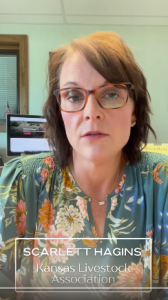By now, you’ve probably seen videos cycling the internet about the “mysterious” and “suspicious” deaths of feedlot cattle in Kansas. These cattle losses have faced speculation and conspiracy over the past week as rumors flooded social media. However, the reason for these losses is likely simple — a heat index crisis. Consumers and producers have continued to share feelings of unrest regarding the dead cattle as natural disasters, facility closures, and inflation continues to batter the agricultural industry. However, when it comes to the loss of these cattle, the causes of death are increasingly clear.
While the news of up to 10,000 cattle perishing in high heat is certainly a shocking and devastating blow to the Kansas cattle feeding industry, it’s important that as agriculturalists, we focus on facts. As consumers, it’s equally integral to understand contributing factors to losses and how the cattle production system works.

The Numbers
All numbers released on cattle deaths are currently speculative — there is no official mechanism in place with which we can enumerate cattle losses. This week alone, over 607,000 head of cattle have been slaughtered at federally inspected facilities in the United States. Death tolls in Kansas, even if they were as high as 10,000, only represent 1 percent of the cattle processed this past week.
Weather Factors
Southwestern Kansas is typically a temperate area that is ideal for cattle feeding. Recent temperatures have been cool and cattle simply did not have the time to acclimate to the high, humid conditions that hit on June 10 and 11. During this time, temperatures increased between 10 and 14 degrees Fahrenheit. The wind died down, and humidity kept the heat index high enough that cattle could not cool down overnight. This phenomenon is referred to as a heat index crisis. While cattle can pant and sweat to reduce body heat, their cooling system is only about 10 percent as effective at dissipating heat through sweat as a human’s.
Cattle Affected
Many of the cattle lost appear to be heavier cattle nearly ready for processing. It’s important to understand that heavier, older calves are the ones that producers have the most money invested in. They’re the ones that cost more to lose; no business wants to take a hit at their most valuable assets.
Cattle are already susceptible to heat loss, but when you add heavier body weight, black hides, any history of respiratory illness, and huge temperature variations to unacclimated individuals, it’s a recipe for disaster.
What are producers doing?
Extreme acts of nature have always had the potential to wreak havoc on agricultural production. Tornados, blizzards, extreme cold, and extreme heat are unfortunately not new to the industry. Producers are constantly at work trying to mitigate losses with preventative measures. Feedlots also already have systems in place for animal disposal.
The USDA’s Livestock Indemnity Program will repay up to 75 percent of the market value of animals lost in excess of normal deaths. Losses need to be reported within 30 days with the Farm Service Agency including documentation of temperatures, heat and humidity before and during the loss period.


